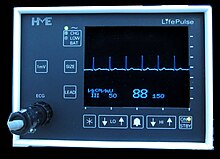
Back Frecuencia cardiaca AN سرعة القلب Arabic হৃৎস্পন্দনের হার Bengali/Bangla Frekvencija srca BS Freqüència cardíaca Catalan Srdeční rytmus Czech Herzfrequenz German Frequèinsa cardìeca EML Porminuta korbatado Esperanto Frecuencia cardíaca Spanish

Heart rate (or pulse rate)[1] is the frequency of the heartbeat measured by the number of contractions of the heart per minute (beats per minute, or bpm). The heart rate varies according to the body's physical needs, including the need to absorb oxygen and excrete carbon dioxide. It is also modulated by numerous factors, including (but not limited to) genetics, physical fitness, stress or psychological status, diet, drugs, hormonal status, environment, and disease/illness, as well as the interaction between these factors.[2] It is usually equal or close to the pulse measured at any peripheral point.
The American Heart Association states the normal resting adult human heart rate is 60–100 bpm. An ultra-trained athlete would have a resting heart rate of 37–38 bpm.[3] Tachycardia is a high heart rate, defined as above 100 bpm at rest.[4] Bradycardia is a low heart rate, defined as below 60 bpm at rest. When a human sleeps, a heartbeat with rates around 40–50 bpm is common and considered normal. When the heart is not beating in a regular pattern, this is referred to as an arrhythmia. Abnormalities of heart rate sometimes indicate disease.[5]
- ^ "What is a normal pulse rate? - Heart Matters magazine - BHF".
- ^ Zhang GQ, Zhang W (2009). "Heart rate, lifespan, and mortality risk". Ageing Research Reviews. 8 (1): 52–60. doi:10.1016/j.arr.2008.10.001. PMID 19022405. S2CID 23482241.
- ^ "All About Heart Rate (Pulse)". All About Heart Rate (Pulse). American Heart Association. 22 Aug 2017. Retrieved 25 Jan 2018.
- ^ "Tachycardia| Fast Heart Rate". Tachycardia. American Heart Association. 2 May 2013. Retrieved 21 May 2014.
- ^ Fuster, Wayne & O'Rouke 2001, pp. 78–79.